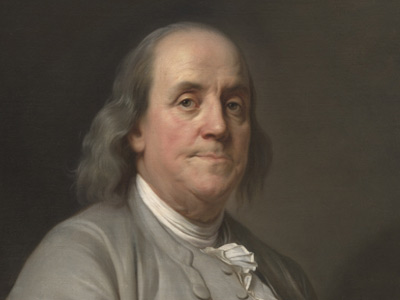Benjamin Franklin (1706-1790)
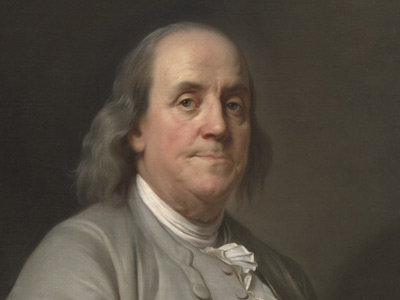
Legacy
A signer of both the Declaration of Independence and the Constitution, Franklin is considered one of the Founding Fathers of the United States. His pervasive influence in the early history of the nation has led to his being jocularly called "the only President of the United States who was never President of the United States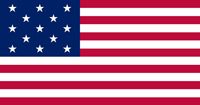 The United States of America (USA), is a country in North America. The American Revolutionary War (April 19, 1775 - September 3, 1783) was the military conflict in which American patriot forces under George Washington's command defeated the British, establishing and securing the independence of the United States. After the Revolution, the United States gained independence, the first nation-state founded on Enlightenment principles of liberal democracy.." Franklin's likeness is ubiquitous. Since 1928, it has adorned American $100 bills, which are sometimes referred to in slang as "Benjamins" or "Franklins." From 1948 to 1963, Franklin's portrait was on the half dollar. He has appeared on a $50 bill and on several varieties of the $100 bill from 1914 and 1918. Franklin appears on the $1,000 Series EE Savings bond. The city of Philadelphia contains around 5,000 likenesses of Benjamin Franklin, about half of which are located on the University of Pennsylvania campus. Philadelphia's Benjamin Franklin Parkway (a major thoroughfare) and Benjamin Franklin Bridge (the first major bridge to connect Philadelphia with New Jersey) are named in his honor.
The United States of America (USA), is a country in North America. The American Revolutionary War (April 19, 1775 - September 3, 1783) was the military conflict in which American patriot forces under George Washington's command defeated the British, establishing and securing the independence of the United States. After the Revolution, the United States gained independence, the first nation-state founded on Enlightenment principles of liberal democracy.." Franklin's likeness is ubiquitous. Since 1928, it has adorned American $100 bills, which are sometimes referred to in slang as "Benjamins" or "Franklins." From 1948 to 1963, Franklin's portrait was on the half dollar. He has appeared on a $50 bill and on several varieties of the $100 bill from 1914 and 1918. Franklin appears on the $1,000 Series EE Savings bond. The city of Philadelphia contains around 5,000 likenesses of Benjamin Franklin, about half of which are located on the University of Pennsylvania campus. Philadelphia's Benjamin Franklin Parkway (a major thoroughfare) and Benjamin Franklin Bridge (the first major bridge to connect Philadelphia with New Jersey) are named in his honor.
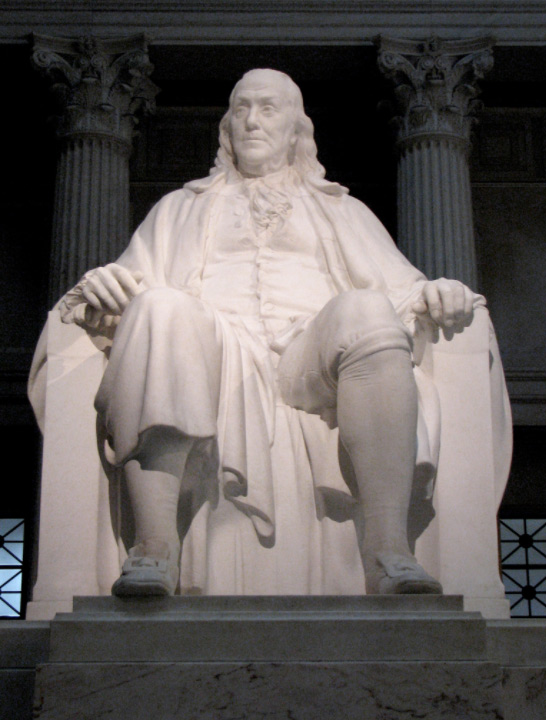
Marble memorial statue, Benjamin Franklin National Memorial
In 1976, as part of a bicentennial celebration, Congress dedicated a 20-foot (6 m) marble statue in Philadelphia's Franklin Institute as the Benjamin Franklin National Memorial. Many of Franklin's personal possessions are also on display at the Institute, one of the few national memorials located on private property.
In London England The Kingdom of England was a sovereign state on the island of Great Britain from about 927, when it emerged from various Anglo-Saxon kingdoms, until 1 May 1707, when it united with Scotland to form the Kingdom of Great Britain. The Viking invasions of the 9th century upset the balance of power between the English kingdoms, and native Anglo-Saxon life in general. The English lands were unified in the 10th century in a reconquest completed by King Æthelstan in 927., his house at 36 Craven Street, which is the only surviving former residence of Benjamin Franklin, was first marked with a blue plaque and has since been opened to the public as the Benjamin Franklin House. In 1998, workmen restoring the building dug up the remains of six children and four adults hidden below the home. The Times reported on February 11, 1998:
The Kingdom of England was a sovereign state on the island of Great Britain from about 927, when it emerged from various Anglo-Saxon kingdoms, until 1 May 1707, when it united with Scotland to form the Kingdom of Great Britain. The Viking invasions of the 9th century upset the balance of power between the English kingdoms, and native Anglo-Saxon life in general. The English lands were unified in the 10th century in a reconquest completed by King Æthelstan in 927., his house at 36 Craven Street, which is the only surviving former residence of Benjamin Franklin, was first marked with a blue plaque and has since been opened to the public as the Benjamin Franklin House. In 1998, workmen restoring the building dug up the remains of six children and four adults hidden below the home. The Times reported on February 11, 1998:
Initial estimates are that the bones are about 200 years old and were buried at the time Franklin was living in the house, which was his home from 1757 to 1762 and from 1764 to 1775. Most of the bones show signs of having been dissected, sawn or cut. One skull has been drilled with several holes. Paul Knapman, the Westminster Coroner, said yesterday: "I cannot totally discount the possibility of a crime. There is still a possibility that I may have to hold an inquest."
The Friends of Benjamin Franklin House (the organization responsible for the restoration) note that the bones were likely placed there by William Hewson, who lived in the house for two years and who had built a small anatomy school at the back of the house. They note that while Franklin likely knew what Hewson was doing, he probably did not participate in any dissections because he was much more of a physicist than a medical man.
HISTORY
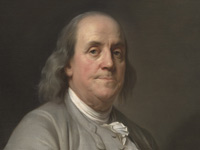
RESOURCES
This article uses material from the Wikipedia article "Benjamin Franklin (1706-1790)", which is released under the Creative Commons Attribution-Share-Alike License 3.0.
© Stories Preschool. All Rights Reserved.
